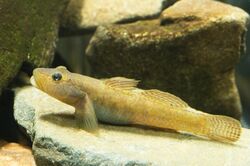Biology:Goby

Goby is a common name for many species of small to medium sized ray-finned fish, normally with large heads and tapered bodies, which are found in marine, brackish and freshwater environments.
Traditionally most of the species called gobies have been classified in the order Perciformes as the suborder Gobioidei but in the 5th Edition of Fishes of the World this suborder is elevated to an order Gobiiformes within the clade Percomorpha.[1] Not all the species in the Gobiiformes are referred to as gobies and the "true gobies" are placed in the family Gobiidae, while other species referred to as gobies have been placed in the Oxudercidae.[1] Goby is also used to describe some species which are not classified within the order Gobiiformes, such as the engineer goby or convict blenny Pholidichthys leucotaenia.[2] The word goby derives from the Latin gobius meaning "gudgeon",[3] and some species of goby, especially the sleeper gobies in the family Eleotridae and some of the dartfishes are called "gudgeons", especially in Australia.[4]
General
Gobies are members of the Gobiidae family, which is a species defined by their spiny pelvic fins that are fused together to work as a ventral sucking disk. This trait allows gobies to adhere to terrain or objects in situations of heavy currents (sometimes even climbing up waterfalls). There are over 2,000 varying species of goby, examples include clown, cleaner, watchman, sand sifting, etc. Gobies vary from 25-75 mm, come in an array of camouflaging hues such as blacks, browns, yellows, oranges, greens. Another characteristic unique to goby is its vertical markings.
Environment
Habitats range throughout the world, from freezing to tropical areas, with the water typically ranging from 25 to 29°C, and salinity is relatively consistent 30 to 35 mg/L. Gobies use small openings they find in reefs or lagoons to protect themselves and their eggs. They rarely venture far from their dens, therefore finding their food and mates within their territory.
Reproduction
Some gobies are hermaphrodites depending on the type, Clean gobies maintain the same sex while Clown gobies are bidirectional hermaphrodites. Gobies often live in breeding pairs and display social monogamy. Once in pairs, breeding and spawning start within a few weeks. Females lay from 50-1000 eggs during one spawning event, males then protect the eggs and dispose any that end up lifeless. Goby eggs are identifiable by their oval shape and are usually 1-2mm in length. These eggs have varying hatch times depending on the species. For example, clean gobies are around 7 days while clown gobies are around 4. Overall, they grow relatively similar after hatching. Their growing patterns should follow these guidelines closely:
- 17 DPH – Fins are visible, growing, and becoming less transparent.
- 25 DPH – The body will become rounder and stomach contents may be visible with a yellow or pink color.
- 26-46 DPH – At around 9 mm, metamorphosis will occur, and the fish are considered adults.
These stages mean the fish is still fragile and susceptible to their environment. Following metamorphosis, Goby fish will continue to grow for about 90 days (about 3 months). If for sale, this is when they would be considered a marketable size.
See also
References
- ↑ 1.0 1.1 J. S. Nelson; T. C. Grande; M. V. H. Wilson (2016). Fishes of the World (5th ed.). Wiley. pp. 752. ISBN 978-1-118-34233-6.
- ↑ Froese, Rainer and Pauly, Daniel, eds. (2018). "Pholidichthys leucotaenia" in FishBase. June 2018 version.
- ↑ "Definition of 'goby'". Collins English Dictionary. https://www.collinsdictionary.com/dictionary/english/goby.
- ↑ Helfman G.; Collette B.; Facey D (1997). The Diversity of Fishes. Blackwell Publishing. p. 264. ISBN 0-86542-256-7.
- DiMaggio, Matt, Jesse Von Linden, Joshua Patterson, and Cortney Ohs. 2020. “Aquaculture Applications of the Family Gobiidae: FA226/FA226, 06/2020”. EDIS 2020 (3):7. https://doi.org/10.32473/edis-fa226-2020.
- Milius, Susan. "Goby Fish React To Corals' Cue By Helping Keep Algae At Bay." Science News 182 no. 11 (2012): 7-8.
- Olivotto, Ike, Alessio Zenobi, Arianna Rollo, Beatrice Migliarini, Matteo Avella, and Oliana Carnevali. "Breeding, Rearing And Feeding Studies In the Cleaner Goby Gobiosoma evelynae." Aquaculture 250 no. 1-2 (2005): 175-182.
- Patterson, Joshua T., Cortney L. Ohs, and Matthew A. DiMaggio. Aquaculture Applications Of The Family Gobiidae.( 2020) doi.org/10.32473/edis-fa226-2020.
- Quintao, Thais L., Ryan Andrades, Raphael M. Macieira, Ana Carolina Loss, and Jean-Christophe Joyeux. "The Evolutionary History Of Priolepis (Gobiidae) In The Atlantic Ocean." Marine Biology 169 no. 7 (2022): 1-17.
 |

